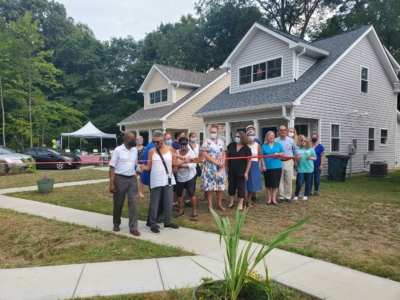
Chase Whiteside, center with microphone, and Erick Stoll, right with camera, made a video about the Sept. 12 “Tea Party” march in Washington, D.C. that has gone viral on the Internet. The two Wright State University film students, who recently moved to town, are shown here interviewing marchers.
Filmmakers strike a nerve with D.C. ‘Tea Party’ march video
- Published: September 24, 2009
You might call this a story about what two guys with passion and a camera can do.
The passion that Chase Whiteside and Erick Stoll share is their desire to help the country achieve health care reform. Toward that end, the Wright State film students traveled to Washington, D. C. to document the Sept. 12 Tea Party march of those who oppose Obama policies. Since they put their nine-minute video, which shows the extreme views of some who attended the march, on YouTube a week ago Monday, it has received more than 600,000 views. This qualifies the video as having “gone viral,” meaning spreading quickly due to people sharing it with friends through Facebook and other social networking sites.
The video can be accessed at http://www.youtube.com/NewLeftMedia.
Because of the video’s widespread attention, the two young men, who this summer moved to Yellow Springs, have been contacted by BBC radio, Air America and a representative of the Bill Moyers Journal on PBS. And a visual segment of their piece aired on the MSNBC Rachel Maddow Show.
“It’s been surreal, very unexpected,” Whiteside said in an interview this week.
Currently seniors at Wright State and students of local filmmakers Julia Reichert and Jim Klein, the two young men together have made four documentaries covering political events. It was at a recent Columbus townhall meeting of Senator Sherrod Brown that they learned of the upcoming march of those opposed to health care reform, and decided to film the event.
With little cash, Whiteside and Stoll left Yellow Springs at 1 a.m. the night before the march, driving straight through to a Washington, D. C. Metro station, where they left their car and hopped on a train. As soon as they got to the Capital Hill site of the march, which they estimated about 70,000 people attended, they began interviewing the marchers. They stayed at the march all day, collecting about four hours of video, then had dinner, got back into their car, and drove straight through the night again. They got home at 4 a.m., slept until noon, and then began looking at their footage. They edited all night and then uploaded the completed video at noon on Monday.
Time was of the essence, they believed, based on previous videos that had spread quickly through the Internet.
“We knew when we were putting it up that if it had a certain quality and speed, it might get attention,” Whiteside said.
And it did get attention, perhaps partly due to the extreme views of those interviewed. Marchers’ signs equated Obama with Hitler and suggested that Obama’s health care plan “should be buried with Kennedy.” Marchers called Obama a Muslim and the Antichrist, and expressed their concern that socialism, facism and communism were taking over the country.
“I was surprised,” Whiteside said, because he expected the marchers to be “the most articulate, most intelligent” representatives of those who oppose Obama’s policies.
While some have criticized the two men for “cherry-picking” their interviews and only showing the most extreme marchers to make a political point, the filmmakers say they did not.
“We don’t believe we misrepresented the march,” Whiteside said. “Everyone we talked to is in the film.”
The marchers they interviewed tended to be evangelical Christians from the South who identified Fox Broadcasting personality Glenn Beck as one of their heroes, according to the men, who saw many marchers as being manipulated by fear-mongering and inaccurate information from right-wing media.
Whiteside and Stoll emphasized that they are not trying to “demonize” those opposed to Obama’s policies, and that they respect those with different views.
“We’re not trying to suggest that there is no basis for an active discussion on the size of government,” Stoll said. “But that discussion is not what was represented at the march.”
While she was proud of her students before they made the film, she’s even more proud of them now, Reichert said in an interview this week.
“They did what independent filmmakers do, going beneath the surface,” Reichert said. “The mainstream media was at the march but they stayed on the perimeters, maybe talking to a person or two. Our kids waded in. They went for more depth than the standard news media.”
While continuing with their film studies, Whiteside and Stoll also plan to continue to document the political realities around them. Their nearterm goal is to do what they can to promote health care reform, especially by using the Internet to engage young people. Those young people voted for Obama overwhelmingly, but have been largely absent from the health care debate, Whiteside said.
“We want to remind people that their work isn’t done until these changes are made,” he said. “Young people need to have their voices heard.”
The Yellow Springs News encourages respectful discussion of this article.
You must login to post a comment.
Don't have a login? Register for a free YSNews.com account.
Parkinsons.jpg)













No comments yet for this article.